As long ago as in the earliest stone churches in Sweden, storage chests were first used for documents, cash and ceremonial objects of gold and silver. The chests were usually made of wood, oak or pine, with strong iron fittings and padlocks. The chests from Voxtorp and Ryssby churches in Småland (see photos below) are unique examples of local Roman metalworking art.
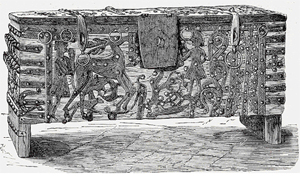 |
| Ironbound chest from Voxtorp Church in Småland, from approximately 1200, built in the Viking manner. It is meant to be secured with three padlocks. Wood engraving, Kyrkliga konsten under Sveriges medeltid [Church art in medieval Sweden]. Swedish Museum of National Antiquities in Stockholm |
 |
| Ironbound chest from Ryssby church in Småland, around 1200. Originally locked with a padlock in the same manner as the Voxtorp chest. Escutcheons and current locks are secondary. Swedish Museum of National Antiquities in Stockholm. Photo Lennart Karlsson |
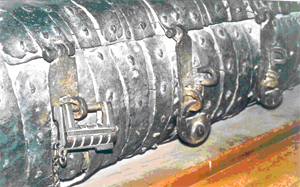 Iron-bound dugout chest made of a hollowed-out log, to which a lid has been attached. It is from the Övergran Church in the district of Håbo in Uppland, where it served as a cash box. The entire length of the chest is clad with vertical forged-iron strips riveted all around – as is the lid, to which are attached four iron hasps, each fastened to the strip on the lid by a hinge. At the other end of each hasp is a hole for a staple that is attached to the chest. Locking is achieved, as shown in the photo below, with a padlock, the bolt of which is passed through the staple. Such dugout chests were used throughout the Middle Ages from the twelfth century on, and the lids were locked with padlocks. Swedish Museum of National Antiquities, Stockholm. Photo by the author.
Iron-bound dugout chest made of a hollowed-out log, to which a lid has been attached. It is from the Övergran Church in the district of Håbo in Uppland, where it served as a cash box. The entire length of the chest is clad with vertical forged-iron strips riveted all around – as is the lid, to which are attached four iron hasps, each fastened to the strip on the lid by a hinge. At the other end of each hasp is a hole for a staple that is attached to the chest. Locking is achieved, as shown in the photo below, with a padlock, the bolt of which is passed through the staple. Such dugout chests were used throughout the Middle Ages from the twelfth century on, and the lids were locked with padlocks. Swedish Museum of National Antiquities, Stockholm. Photo by the author.
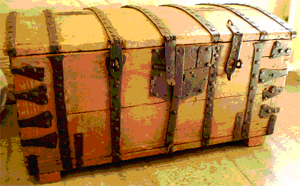 |
| Ironbound wooden money chest with drop fork lock for turning key and adapted for two padlocks. Rogslösa church, Östergötland. Photo by the author. |
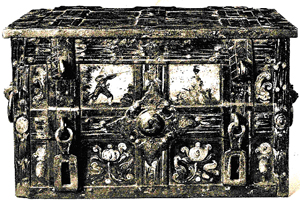 |
| Money chest, second half of sixteenth century. Nordiska museet (Nordic museum), Stockholm |
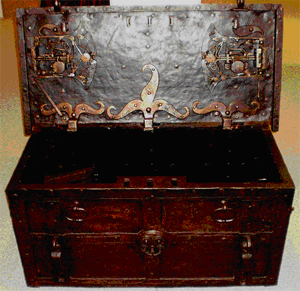 |
| Money chest made of iron in southern Germany. Sixteenth century. Locked with trunk lock in front, two locks in the lower edge of the lid and double padlocks. Hanns Schell Collection, Graz. Photo by the author. |